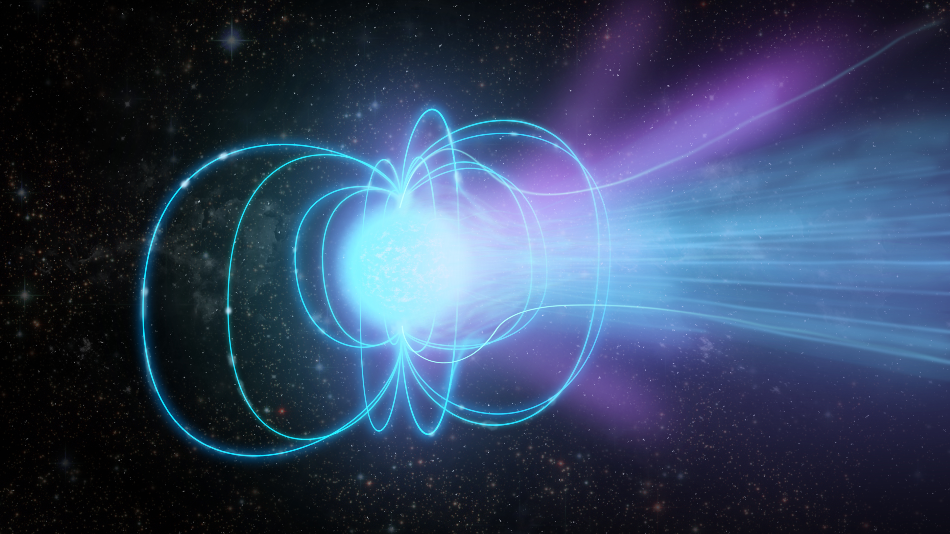Sep 21 2020
For the first time, astronomers utilizing the Very Long Baseline Array (VLBA) of the National Science Foundation have made a direct geometric measurement of the distance to a magnetar inside the Milky Way Galaxy. Such a measurement could help establish whether magnetars are the actual sources of the long-enigmatic Fast Radio Bursts (FRBs).
 Artist’s conception of a magnetar—a superdense neutron star with an extremely strong magnetic field. In this illustration, the magnetar is emitting a burst of radiation. Image Credit: Sophia Dagnello, National Radio Astronomy Observatory/Associated Universities, Inc./National Science Foundation.
Artist’s conception of a magnetar—a superdense neutron star with an extremely strong magnetic field. In this illustration, the magnetar is emitting a burst of radiation. Image Credit: Sophia Dagnello, National Radio Astronomy Observatory/Associated Universities, Inc./National Science Foundation.
Magnetars are essentially a range of neutron stars (the superdense remnants of giant stars that exploded as supernovae) with very powerful magnetic fields. The magnetic field of a standard magnetar is a trillion times stronger than the magnetic field of the Earth’s, rendering magnetars the most magnetic objects to exist in the Universe.
Magnetars can produce powerful bursts of gamma rays and X-rays, and lately have become a top candidate for the sources of FRBs.
The First Parallax Measurement for a Magnetar
XTE J1810-197 is a magnetar detected in 2003. This star was the first of only six such celestial objects that were found to discharge radio pulses. The magnetar did so from 2003 to 2008 and then stopped for 10 years. Back in December 2018, it continued to produce bright radio pulses.
The VLBA was used by a group of astronomers to frequently visualize the XTE J1810-197 magnetar from January to November of 2019, and then again during March and April of 2020. By observing the magnetar from reverse sides of the Earth’s orbit around the Sun, the astronomers effectively detected a mild shift in its apparent position with regard to background objects located much more remotely. Known as parallax, this effect enables astronomers to utilize geometry to directly compute the distance of the object.
This is the first parallax measurement for a magnetar, and shows that it is among the closest magnetars known—at about 8100 light-years—making it a prime target for future study,
Hao Ding, Graduate Student, Swinburne University of Technology
On April 28th, 2020, a short radio burst was emitted by another magnetar, known as SGR 1935+2154. This was the strongest radio burst to be ever recorded from within the Milky Way Galaxy. Although not as powerful as FRBs emerging from other galaxies, this burst indicated to astronomers that magnetars can possibly produce FRBs.
Astronomers had initially discovered FRBs in 2007. These bursts are highly energetic and can last at most a few milliseconds. A majority of these bursts have come from beyond the Milky Way. While their origin continues to be vague, their properties have indicated that the extreme surrounding of a magnetar could produce them.
Having a precise distance to this magnetar means that we can accurately calculate the strength of the radio pulses coming from it. If it emits something similar to an FRB, we will know how strong that pulse is. FRBs vary in their strength, so we would like to know if a magnetar pulse comes close or overlaps with the strength of known FRBs.
Adam Deller, Swinburne University
“A key to answering this question will be to get more distances to magnetars, so we can expand our sample and obtain more data. The VLBA is the ideal tool for doing this,” stated Walter Brisken from the National Radio Astronomy Observatory.
We know that pulsars, such as the one in the famous Crab Nebula, emit ‘giant pulses,’ much stronger than their usual ones. Determining the distances to magnetars will help us understand this phenomenon, and learn if maybe FRBs are the most extreme example of giant pulses.
Hao Ding, Graduate Student, Swinburne University of Technology
The ultimate objective is to establish the actual mechanism that creates FRBs, added the researchers.
Ding, Deller, Brisken, and their collaborators have reported the results of their study in the Monthly Notices of the Royal Astronomical Society.
The National Radio Astronomy Observatory is a facility of the National Science Foundation, operated under cooperative agreement by Associated Universities, Inc.
Journal Reference:
Ding, H., et al. (2020) A magnetar parallax. Monthly Notices of the Royal Astronomical Society. doi.org/10.1093/mnras/staa2531.